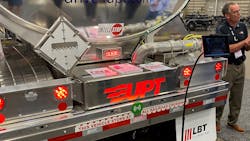Intellistop’s pulsating rear lamp module caught in bureaucratic darkness
Almost any commercial vehicle traveling American highways can do so with brand-new technology aboard because the U.S. regulatory structure has holes in it. But when it comes to new equipment, fresh from the factory, a simple yet effective system that adjusts the way trailer brake lights work can become mired in a bureaucratic morass. One industry newcomer, the manufacturer of a device that pulsates rear stop lamps in an effort to reduce rear-end collisions, is learning this the hard way.
The Federal Motor Carrier Safety Administration (FMCSA) in the last three years has granted four exemptions that allow brake-activated pulsating rear lamps on equipment already in operation with fleets. Tank truck carrier Groendyke Transport secured the first such waiver three years ago, and trash hauler Waste Management obtained the most recent one, just in January.
See also: How technology can impact a fleet’s insurance policy
But a similar application for an exemption from FMCSA regulations, filed by Intellistop in December 2020 and published in the Federal Register last June, has yet to be approved—long after FMCSA was expected to decide; applications usually take 180 days from receipt to a decision from the agency. So, what’s the holdup with Intellistop’s application? Turns out, the delay has to do with federal agencies trying to figure out which of them has jurisdiction.
According to a recent email from Jack Van Steenburg, FMCSA’s executive director and chief safety officer, FMCSA may not have the authority to grant an exemption to a manufacturer on behalf of motor carriers who voluntarily “choose” to use Intellistop’s product to reduce rear-end crashes that are costly in terms of equipment damage and injuries and deaths and with nuclear verdicts at jury trials.
While FMCSA regulates “in-use” operation of commercial vehicles over 10,000 lb. in interstate commerce, it’s the National Highway Traffic Safety Administration (NHTSA) that oversees the safety of newly manufactured vehicles, equipment, and, in this case, technology—as covered by a Federal Motor Vehicle Safety Standard (FMVSS), according to Van Steenburg.
And though FMCSA's and NHTSA's missions are virtually identical—to save lives by reducing crashes—they’re proceeding as if they’re on opposing sides—and in doing so they're indefinitely idling a promising solution for the problem of rear-end collisions, which aren’t improving nationwide.
That’s because, if Van Steenburg’s email to Intellistop is correct, and FMCSA is forced to deny the exemption, the agency’s decision would be based on NHTSA’s interpretation of the words “make inoperative” in the FMVSS; and FMCSA already has granted many parts and accessories exemptions for technologies that essentially render vehicles inoperative after they’re sold—and could be bound by law to go back and undo all of them.
“You can’t go halfway in,” Intellistop President Michelle Hanby insists. “You can’t say, ‘We’re just not going to let this one happen.’ If this is really how you feel, then every manufacturer that’s been granted an exemption is probably going to be under the microscope, and that’s only taking us backward on safety.”
Vehicle standards
Today’s U.S. brake lamp standards, including the steady-burn requirement, were developed in the 1960s, during the time of the Interstate Commerce Commission, and were later standardized by the National Traffic and Motor Vehicle Safety Act of 1966, four years before NHTSA was created.
A review of the history of rear-lighting systems, “Historical Development and Current Effectiveness of Rear Lighting Systems,” conducted in 1999 by the University of Michigan Transportation Research Institute, doesn’t mention the phrase “steady burning” but points to difficulties with early electrical systems and rear lamps, including greater exposure to dirt, corrosion, and damage that reduced their effectiveness or intensity levels, as a rationale for the requirement. If the lamps weren’t staying on, it likely was due to faulty wiring or a malfunctioning light. That’s not the case with today’s sealed LED lighting and advanced vehicle technology that supports LEDs.
On the regulatory front, NHTSA regulates the assembly of “new” motor vehicles, and FMCSA regulates the operation of “used” commercial vehicles. While NHTSA is charged with ensuring that vehicles meet pre-sale standards, FMCSA is responsible for ensuring they are properly maintained. So, like any two family members, they don’t always agree on what is most important—as with their differing stances on the safety benefits of “pulsating” brake lamps.Flashing lights
Barry Detlefsen, vice president of safety at San Antonio-based Coastal Transport, previously spent 40 years with the Texas Department of Public Safety Highway Patrol, specializing in commercial vehicle enforcement. He’s intimately familiar with commercial vehicle standards, driver behavior—which he says is worsening due to increasing vehicle automation and, of course, cell phones—and the persistent threat of rear-end crashes.
FMCSA’s Report to Congress, the Large Truck Crash Causation Study (LTCCS), jointly undertaken with NHTSA, examined 967 crashes that included 1,127 large trucks, 959 non-truck motor vehicles, 251 fatalities, and 1,408 injuries. The study showed the largest percentage of crashes were rear-end collisions (23.1%). Additionally, NHTSA’s Fatality Analysis Reporting System (FARS) indicates rear impacts accounted for 19.3% of fatal crashes (964) involving large trucks in 2019.
Among the critical reasons for crashes identified in the LTCCS, inattention—or a lack of recognition—led to 35% of the crashes in trucks. So how do you better gain drivers’ attention, and reduce the frequency of costly rear-end collisions? Through flashing lights and movement, Detlefsen said. “The human eye is attracted to movement and flashing lights,” he said. “That’s how we’re wired.”
Since humans are wired to notice flashing lights, they could help reduce rear-end collisions if built into brake lamps. The only problem is those two pesky words—“steady” and “burning”—in the FMVSS.
NHTSA examined enhanced rear lighting and signaling systems for a report published in 2002 that mentioned numerous attempts to develop flashing brake systems as far back as the 1970s. But, NHTSA said, “without additional scientific research showing that a flashing lamp will be detected significantly faster than a steady-burning lamp, NHTSA will not consider altering the standard.” Then, in 2009—nearly 13 years ago—NHTSA published its “Evaluation of Enhanced Brake Lights Using Surrogate Safety Metrics,” which acknowledged that “previous work had shown promise for reducing the number and severity of rear-end crashes” and that its current work indicated “flashing improves rated attention getting.”
Exemption solution
Despite the evidence gathered, NHTSA has not moved to revise the standard. So fleets, manufacturers, and the FMCSA developed and allowed their own solution. Unlike flashing lights, which turn off and on, “pulsating” lights dim and brighten by modulating the voltage, so they maintain a “steady burn,” meeting the FMCSA standard, while creating the perception of flashing.
Groendyke was the first fleet to test amber, brake-activated, center high-mounted stoplights on its trailers as a way to reduce rear-end collisions. It’s study, conducted from 2015 to 2017, which included 632 tank trailers, revealed trailers with brake-activated pulsating lights and steady-burning brake lamps were involved in 33.7% fewer rear-end collisions than trailers with only steady-burning red lamps. Groendyke, however, also attracted unwanted attention from law enforcement during testing, so it opted to pursue an exemption.
According to Van Steenburg’s email, FMCSA and NHTSA officials met to discuss FMCSA’s plan to grant Groendyke’s exemption. NHTSA was hesitant to do so, but an associate administrator for NHTSA’s rulemaking division gave his blessing, and FMCSA moved forward. But the agency was then “bombarded” by requests from other bulk haulers for the same exception. So, to avoid granting thousands of related exemptions—National Tank Truck Carriers says there are more than 20,000 tank truck carriers in the country—NTTC gained an exemption in October 2020, clearing the way for carriers to equip red or amber brake-activated pulsating lamps on the rear of tank trailers.Grote Industries, a lamp manufacturer, also received a pulsating brake lamp exemption in December 2020 that included van body trucks. Waste Management’s rear-lamp exemption covering its commercial vehicles was granted on Jan. 20.
None of these exemptions make pulsating lamps mandatory. They simply afford carriers the option of adding technology NHTSA’s own research indicates may help protect them from inattentive drivers. Granting Intellistop’s exemption would allow carriers to operate its brake-activated warning lamp module without fear of fines. So why hasn’t FMCSA approved the company’s exemption request? Officially, the agency said DOT has the exemption request under active review.
Public comments published on the Federal Register overwhelmingly support Intellistop’s exemption request. American Trucking Associations supports the use of the Intellistop module, which was NTTC’s preferred solution in its study conducted with Tankstar USA.
Unstoppable
Other carriers are waiting on FMCSA’s decision. Hanby admits she didn’t think she would be in this situation when she started Intellistop in 2019.
As far as she’s concerned, U.S. Secretary of Transportation Pete Buttigieg should be grateful for a technology solution handed to him on a silver platter, considering he said during CES 2022 the federal government will pave the way for innovation in transportation by helping companies bring technology to the market. “We should plan proactively to support the growth of new ideas and make sure that Americans share the benefits,” Buttigieg said.
Yet a woman-supplied solution that is easier for everyone, including carriers, manufacturers, and FMCSA, still is languishing in bureaucratic purgatory—under an administration that says it is committed to diversity—despite all the evidence in its favor. “I believe I’m in a turf war,” Hanby confided.
Fortunately for carriers, she isn’t one to shy away from a fight. Especially not this one.
Hanby’s mother was killed by a distracted driver on Nov. 12, 1993, while on her way to watch her daughter play basketball for Arkansas. She was 50 years old at the time—the same age as Hanby is now. Texas A&M women’s basketball coach Gary Blair, then the new coach at Arkansas, mentioned the tragedy in his memoir, “A Coaching Life." That life-altering incident led Hanby and a partner to start BrakePlus, which provides owner-installed pulsating brake light modules for passenger vehicles, more than 10 years ago.
Van Steenburg’s email to Hanby indicates Intellistop’s exemption request has been elevated to a “policy decision.” If it’s ultimately denied, Hanby, who’s already reached out to congressmen in multiple states, plans to retain legal counsel, and then turn her attention to changing the regulation—and she fully expects to have the support of countless commercial motor vehicle manufacturers and carriers in her corner.
Editor's note: Read the full investigative report from FleetOwner's sister publication, Bulk Transporter here.
About the Author

Jason McDaniel
Jason McDaniel, based in the Houston TX area, has nearly 20 years of experience as a journalist. He spent 15 writing and editing for daily newspapers, including the Houston Chronicle, and began covering the commercial vehicle industry in 2018. He was named editor of Bulk Transporter and Refrigerated Transporter magazines in July 2020.



